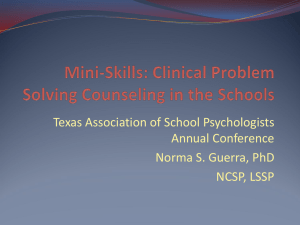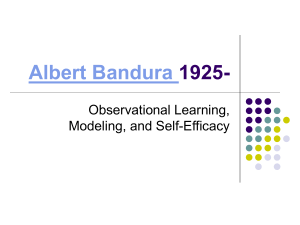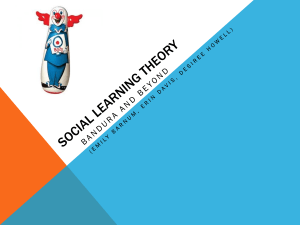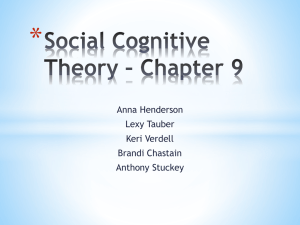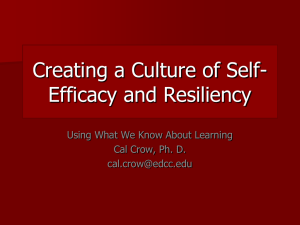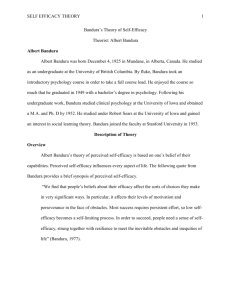Moving On: Preparing Students for Life After the First Year
advertisement
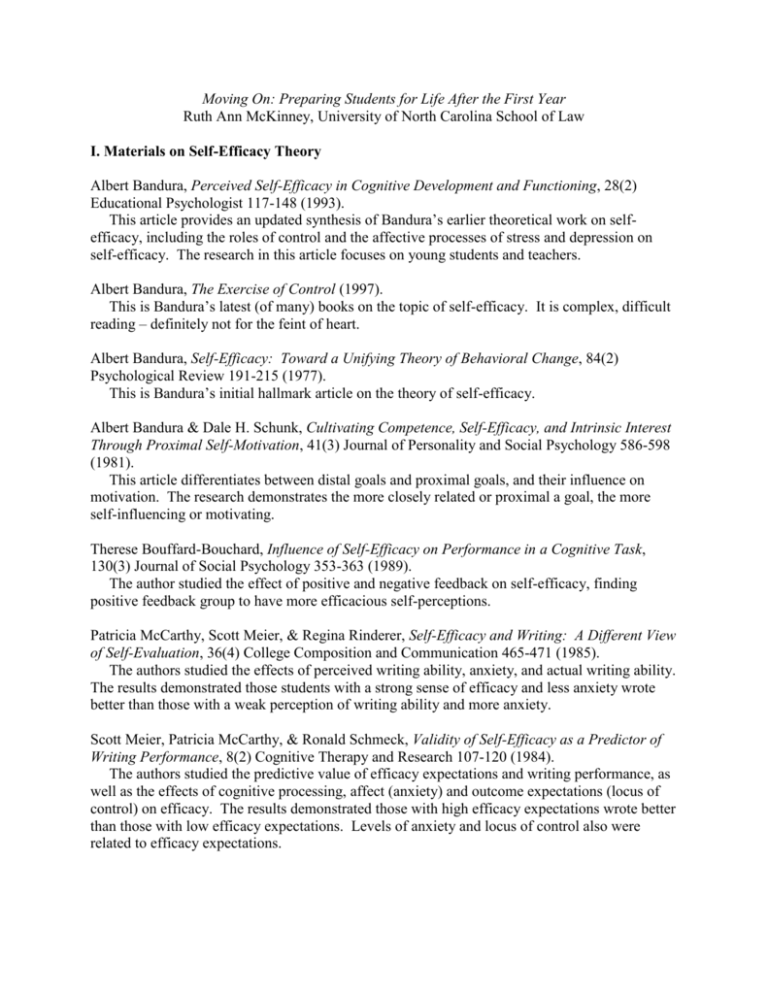
Moving On: Preparing Students for Life After the First Year Ruth Ann McKinney, University of North Carolina School of Law I. Materials on Self-Efficacy Theory Albert Bandura, Perceived Self-Efficacy in Cognitive Development and Functioning, 28(2) Educational Psychologist 117-148 (1993). This article provides an updated synthesis of Bandura’s earlier theoretical work on selfefficacy, including the roles of control and the affective processes of stress and depression on self-efficacy. The research in this article focuses on young students and teachers. Albert Bandura, The Exercise of Control (1997). This is Bandura’s latest (of many) books on the topic of self-efficacy. It is complex, difficult reading – definitely not for the feint of heart. Albert Bandura, Self-Efficacy: Toward a Unifying Theory of Behavioral Change, 84(2) Psychological Review 191-215 (1977). This is Bandura’s initial hallmark article on the theory of self-efficacy. Albert Bandura & Dale H. Schunk, Cultivating Competence, Self-Efficacy, and Intrinsic Interest Through Proximal Self-Motivation, 41(3) Journal of Personality and Social Psychology 586-598 (1981). This article differentiates between distal goals and proximal goals, and their influence on motivation. The research demonstrates the more closely related or proximal a goal, the more self-influencing or motivating. Therese Bouffard-Bouchard, Influence of Self-Efficacy on Performance in a Cognitive Task, 130(3) Journal of Social Psychology 353-363 (1989). The author studied the effect of positive and negative feedback on self-efficacy, finding positive feedback group to have more efficacious self-perceptions. Patricia McCarthy, Scott Meier, & Regina Rinderer, Self-Efficacy and Writing: A Different View of Self-Evaluation, 36(4) College Composition and Communication 465-471 (1985). The authors studied the effects of perceived writing ability, anxiety, and actual writing ability. The results demonstrated those students with a strong sense of efficacy and less anxiety wrote better than those with a weak perception of writing ability and more anxiety. Scott Meier, Patricia McCarthy, & Ronald Schmeck, Validity of Self-Efficacy as a Predictor of Writing Performance, 8(2) Cognitive Therapy and Research 107-120 (1984). The authors studied the predictive value of efficacy expectations and writing performance, as well as the effects of cognitive processing, affect (anxiety) and outcome expectations (locus of control) on efficacy. The results demonstrated those with high efficacy expectations wrote better than those with low efficacy expectations. Levels of anxiety and locus of control also were related to efficacy expectations. Karen Multon, Steven Brown, & Robert Lent, Relation of Self-Efficacy Beliefs to Academic Outcomes: A Meta-Analytic Investigation, 38(1) Journal of Counseling Psychology 30-38 (1991). The authors performed a meta-analysis on studies done from 1977 to 1988 on self-efficacy and academic performance and persistence. They confirmed the positive relationship between high self-efficacy and high academic performance. ** Self-Efficacy, Adaptation, and Adjustment: Theory, Research, and Application (James E. Maddux, ed., 1995). This book provides an excellent overview of the theoretical basis of self-efficacy, and it’s applications in clinical psychology (including anxiety and depression), health behaviors, career choice, education and instruction, and outcome expectancy. Summaries of research on selfefficacy are also included in each discussion. This is definitely the resource to begin with if you are interested in getting an overview of the general principles of self-efficacy, social cognitive theory, and much of the recent literature in this field. Duane Shell, Carolyn Murphy, & Roger Bruning, Self-Efficacy and Outcome Expectancy Mechanisms in Reading and Writing Achievement, 81(1) Journal of Educational Psychology 91100 (1989). The authors studied the relationships between self-efficacy beliefs, outcome expectancies, and reading and writing performance. The results demonstrated self-efficacy beliefs are more strongly related to achievement than outcome expectancies for reading and writing. The findings also suggest that self-efficacy and achievement may become stronger as proficiency increases. Ellen Skinner, James Wellborn, & James Connell, What it Takes to Do Well in School and Whether I’ve Got It: A Process Model of Perceived Control and Children’s Engagement and Achievement in School, 82(1) Journal of Educational Psychology 22-32 (1990). The authors studied perceived control and achievement in school, strategies to produce achievement, and capacity to execute those strategies. Barry Zimmerman & Albert Bandura, Impact of Self-Regulatory Influences on Writing Course Attainment, 31(4) American Educational Research Journal 845-862 (1994). The authors studied the effects of perceived self-regulatory efficacy, self-evaluative standards, and perceived academic self-efficacy on writing performance. The authors found students with high self-efficacy set higher goals and performed on a higher level. Barry Zimmerman, Albert Bandura, & Manuel Martinez-Pons, Self-Motivation for Academic Attainment: The Role of Self-Efficacy Beliefs and Personal Goal Setting, 29(3) American Educational Research Journal 663-676 (1992). This study demonstrated the effect of perceived self-efficacy on motivation, academic performance, and personal goal setting. II. Materials on Legal Pedagogy, Law Student Stress, and Stress in the Profession G. Andrew & H. Benjamin, Psychiatric Distress in Law Students, 35 J. LEGAL EDUC. 65 (1985). Intriguing, though highly speculative, article discussing the results of a 1979 study that compared the psychiatric distress levels of 232 law students to those of 262 medical students. The authors theorize that (1) individuals with higher ongoing levels of distress or higher potentials for psychiatric symptoms under stress may be attracted to law school and/or (2) the differences in the learning environments may account for the higher levels of distress in law students. James Archer, Jr. and Martha M. Peters, Law Student Stress, 23 NASPA Journal 48 (Spring 1986). A detailed empirical study of law student stressors as experienced by students at the University of Florida College of Law. Includes also a brief overview of related literature. Professor Peters has authored a number of other interesting articles on stress and stress management for law students and the profession. Arthur Austin, One Person’s Challenge is Someone Else’s Stress, 3 TEX. REV. OF L. & POL. 157 (1998). Article reviewing the 1997 book, “Proceed with Caution: Diary of the First Year of One of America’s Largest, Most Prestigious Law Firms” by William R. Keates. Austin also brings into the discussion several other books which he describes as part of the “victim autobiographies] [that have] roots emanating from the law academy” (157). G. Andrew H. Benjamin, Alfred Kaszniak, Bruce Sales & Stephen B. Shanfield, The Role of Legal Education in Producing Psychological Distress Among Law Students and Lawyers, AM. B. FOUND. RES. J. 225 (1986). Informative article presenting the results of a study assessing the hypothesis that the process of legal education “impairs the maintenance of emotional well-being” in law students (225). These authors found significantly elevated levels of obsessive-compulsive behavior, depression, anxiety, (among others) in law students as compared to medical students and to the population at large. Paul D. Carrington & James J. Conley, The Alienation of Law Students, 75 MICH. L. REV. 887 (1977). Absorbing article discussing the results of a 1976 study of 185 law students at the University of Michigan and asserting that, while substantial increases in law school admission standards has reduced the number of first-year students who physically drop out of law school, “roughly one in seven Michigan law students now drops out emotionally and intellectually without formally with-drawing from the school” (887). Matthew M. Dammeyer & Narina Nunez, Anxiety and Depression Among Law Students: Current Knowledge and Future Directions, 23 LAW & HUM. BEHAV. 55 (1999). Newer article reviewing the contemporary literature regarding anxiety and depression among law students, and critiquing the various methodologies used in the studies performed by other researchers. The authors also comment on “Selection” theories versus “Socialization” theories, and hypothesize that selection and socialization forces may actually combine to produce the findings that have been reported in the various studies. Marilyn Heins, Shirley Nichols Fahey & Roger C. Henderson, Law Students and Medical Students: A Comparison of Perceived Stress, 33 J. LEGAL EDUC. 511 (1983). Article discussing the results of a study comparing the stress levels of 105 second-year law students to 122 second- and third-year medical students. While it was hypothesized that medical students would fare worse than law students, the data instead suggested that law students in fact had significantly higher levels of “fear of failing stress,”“academic stress,” and self-doubt. J.S. St. Lawrence, M.L. McGrath, M. Oakley & S.C. Sult, Stress Management Training for Law Students, 4 BEHAV. SCI. & L. 101 (1983). Discusses the marked differences in stress levels between law students who participated in a stress management training program compared to those who did not. Also provides an overview of the intervention strategies employed, such as time management training, cognitive modification strategies, and deep muscle relaxation techniques coupled with the use of relaxing imagery. Paula Lustbader, Construction Sites, Building Types, and Bridging Gaps: A Cognitive Theory of the Learning Progression of Law Students (an unpublished work available from the author at the University of Seattle School of Law). In this article, the author develops a fascinating theory of student learning based on cognitive developmental models. She hypothesizes that students progress through four stages of legal learning, and documents her findings with examples of student work. Her theory, and this article, provide an excellent source of information for educators interested in developing materials that are appropriate for law students at various stages of learning. Paula Lustbader, From Dreams to Reality: The Emerging Role of Law School Academic Support Programs, 31 U.S.F. L. REV. 839 (1997). Discusses how Academic Support Programs can help students learn new patterns of thought by relating and developing legal concepts based on students’ prior experience, and thus help students to outperform standard predictors such as LSAT scores. N.C. Bar Ass’n, Report of the Quality of Life Task Force (June 20, 1991) Reports results of extensive survey of practicing attorneys in North Carolina, concluding that the statistics in North Carolina are similar to those found nationally. Burnele v. Powell, A Defense of the Socratic Method: An Interview with Martin B. Louis (193494), 73 N.C. L. Rev. 957 (1995). This article offers a view of the Socratic method as seen through the eyes of a traditional law professor who supported it as an essential ingredient of legal learning and professional growth. Lawrence Silver, Anxiety and the First Semester of Law School, ___WIS. L. REV. 1201 (1968). Article discussing the results of a 1966-67 study of nine first-year law students at the University of Wisconsin. The basic finding was that there was an intense concern about failing (dubbed: “failure-anxiety”) and the authors assert that this fear was intensified as the semester progressed because the students were unable to get feedback to determine how well or poorly he was doing. This lack of feedback caused the students to rely on false feedback, encouraged ineffective study habits, and interfered with the students’ overall academic success. James B. Taylor, Law School Stress and the ‘Deformation Professionelle 27 J. LEGAL EDUC. 251 (1975). Article reviewing claims that large, impersonal law school classes, the case study approach, the Socratic method of teaching, and the harsh competition among students are creating a “warping of personality” and are “undermining ethical or social values” (251). The author considers expert testimony, evidence from empirical studies, and the author’s own pilot study comprising twenty hours of group discussion with first-, second-, and third-year law students.
